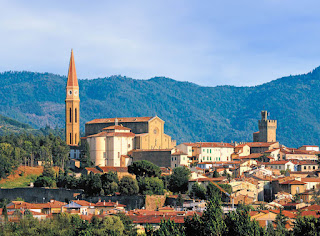Edward Hutton completed his tour of Siena and southern Tuscany with a long chapter on Arezzo. He devoted most of the chapter to an account of the works of Piero della Francesca that he found in its churches: the Legend of the True Cross, and an image of Mary Magdalen.
Rome, Florence, Siena, Assisi are what they are because of the nature of the country in which they lie. It is the same with Arezzo. Her incommunicable allure strikes you at once as soon as you enter her gates—a certain smiling aspect, subtle and discreet and yet very charming and simple seeming in its welcome, its pleasantness and serenity. Yet nothing, I think, in the history of Arezzo…would lead you to expect an aspect so happy, so merely delightful. Nothing in her history! But I am wrong, for it was here both Maecenas and Petrarch were born. It would be impossible to doubt it even though we had no irrefutable proof of the fact, and indeed I think no men have better expressed their birthplace unless—well, unless it be Vasari, who was also an Aretine. These three men perfectly explain Arezzo; its orderliness, its delight, its extraordinary charm, its profound disregard of anything that matters, of anything but a certain décor and endless gossip. … (297)
It is as a city of profound quiet that we find her today, set with trees and great open spaces within her fair walls of brick at the head of those three valleys at the foot of the mountains.
Full of monuments as she is to her illustrious dead, it is not to them but to her churches we look for evidence of her splendour. Nor are we disappointed, for her churches perfectly reflect her history—they are full of the best works of alien masters.
There is S. Francesco, for instance, which one comes to first on leaving the station: a Franciscan church, of course, built nobly in the Franciscan style in 1322…. But what we come to S. Francesco to see is not the work of such masters as these, but the strong and beautiful work of Piero della Francesca in the choir—work that one cannot better anywhere in Tuscany, nor, indeed, easily find its match.
The legend of the Holy Cross, its history from the beginning of the world until it was discovered by the Emperor Heraclius and later by S. Helena, which Piero della Francesca has painted here—by far the most considerable piece of work that he achieved during his whole life—is one of the most curious dreams of the Christian mind. No longer upheld in its entirety by the Catholic church, it is nevertheless true in its intention, since, for the Middle Age, at least, the Cross was indeed a lovely branch of the Tree of Life which is in the midst of the Paradise of God…. (306)
It is this golden legend that Piero has painted so vigorously here in the choir of S. Francesco. How far are we in contemplating these frescoes from the passionate asceticism, the unearthly beauty of Fra Angelico or Simone Martini! It is as though a new desire had suddenly been born into the world—a desire for life where Simone, after all, would have been content with beauty. What magnificent vitality have those beautiful women, how valiant are those men, how puissant those angels! And, above all, Piero has filled heaven and earth with radiant light. It is in the clear and nimble air, in the fair white light of our real and beautiful daylight, that he alone of his contemporaries has dared at last to paint man and woman in all the sweet energy of life, full of that long breath of God which at dawn in a garden first gave us light…. (311)
One lonely and magnificent figure he left behind him at Arezzo in the Cathedral—a figure of S. Mary Magdalen, very noble and reticent. She adorns no altar, but in a quiet corner of the great church… she stands very sorrowful, she alone of all those clouds on clouds of saints really understands. Well, it is always so; we find Piero emotionally under the influence of the Middle Age, and yet himself perhaps a kind of emancipator or deliverer from its mysticism… For he, too, was occupied rather with his art than with the expression of ideas about religion. He was the first painter, perhaps, to study perspective scientifically. Problems of light, the action of light on beautiful faces or hair, the action of light upon light, would certainly seem to have fascinated him almost all his life long. And yet he has not discarded the ideas that were then gradually becoming less insistent in the world, but in all their modesty and beauty he has used them without question as a means of attaining a beauty bought with much toil and feverish endeavour. His Magdalen is not the ecstatic and splendid courtesan that we see in Titian’s canvas, but a beautiful and lonely woman, who will ever remember that lingering dawn in the garden, when, in the midst of her passionate weeping, the gardener came so quietly and spoke her name, and in a moment she knew Him whom she had loved. (313)
###




No comments:
Post a Comment